Citroen NEMO 2015 1.G Owner's Manual
Manufacturer: CITROEN, Model Year: 2015, Model line: NEMO, Model: Citroen NEMO 2015 1.GPages: 192, PDF Size: 7.84 MB
Page 141 of 192
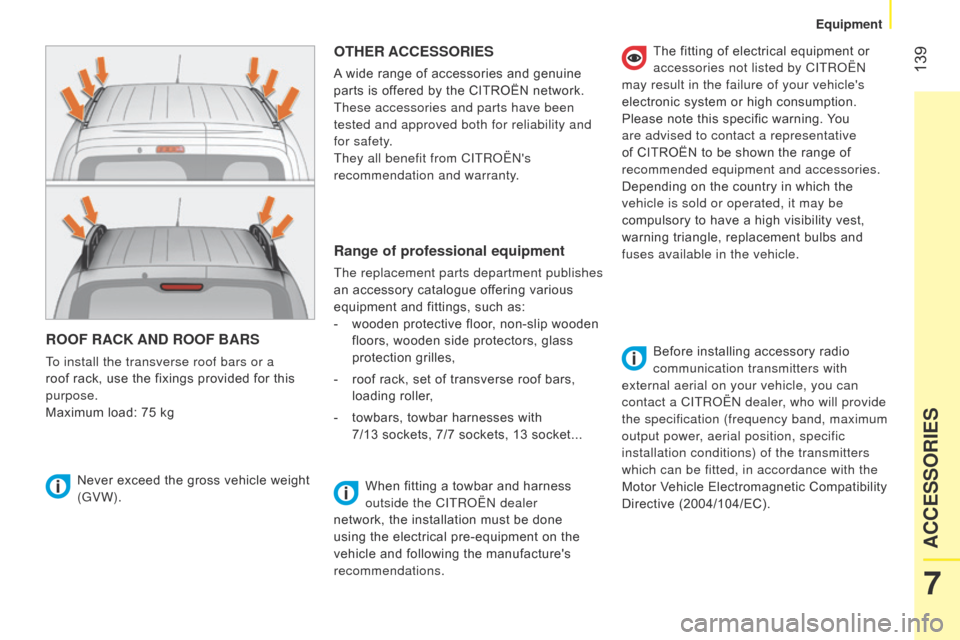
139
ROOF RACK AND ROOF BARS
To install the transverse roof bars or a
roof rack, use the fixings provided for this
purpose.
Maximum load: 75 kg
OTHER ACCESSORIES
A wide range of accessories and genuine
parts is offered by the CITROËN network.
These accessories and parts have been
tested and approved both for reliability and
for safety.
They all benefit from CITRo Ë n 's
recommendation and warranty.
Never exceed the gross vehicle weight
(GVW).
Range of professional equipment
The replacement parts department publishes
an accessory catalogue offering various
equipment and fittings, such as:
-
wooden protective floor
, non-slip wooden
floors, wooden side protectors, glass
protection grilles,
-
roof rack, set of transverse roof bars,
loading roller,
-
towbars, towbar harnesses with
7/13 sockets, 7/7 sockets, 13 socket... The fitting of electrical equipment or
accessories not listed by CITR
o Ë n
may result in the failure of your vehicle's
electronic system or high consumption.
Please note this specific warning. You
are advised to contact a representative
of CITROËN to be shown the range of
recommended equipment and accessories.
Depending on the country in which the
vehicle is sold or operated, it may be
compulsory to have a high visibility vest,
warning triangle, replacement bulbs and
fuses available in the vehicle.
Before installing accessory radio
communication transmitters with
external aerial on your vehicle, you can
contact a CITR
o Ë n dealer, who will provide
the specification (frequency band, maximum
output power, aerial position, specific
installation conditions) of the transmitters
which can be fitted, in accordance with the
Motor Vehicle Electromagnetic Compatibility
Directive (2004/104/EC).
When fitting a towbar and harness
outside the CITR
o Ë n dealer
network, the installation must be done
using the electrical pre-equipment on the
vehicle and following the manufacture's
recommendations.
7
ACCESSORIES
Equipment
Page 142 of 192
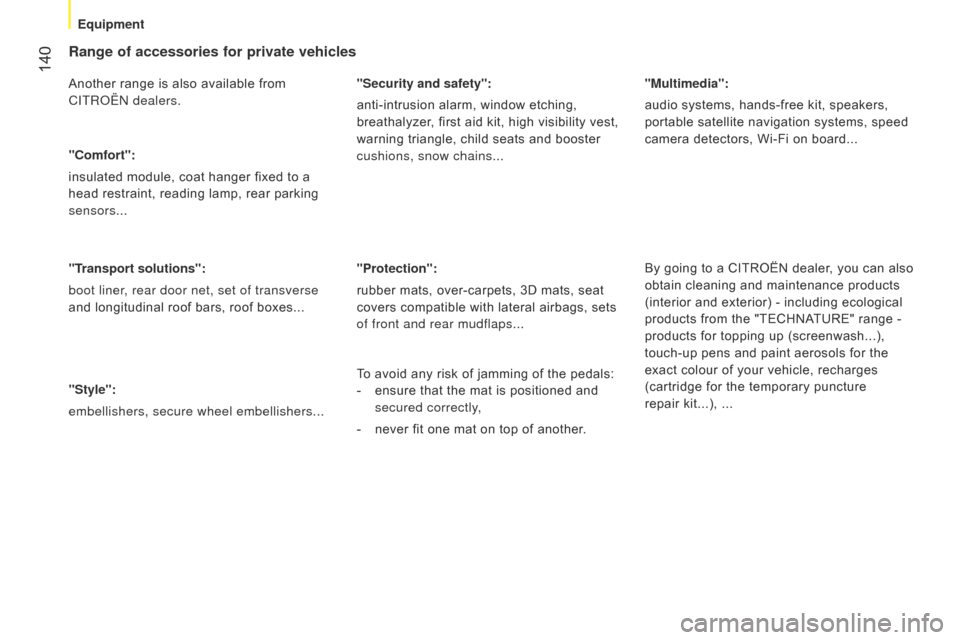
140
Range of accessories for private vehicles
Another range is also available from
CITRo Ë n dealers.
"Comfort":
insulated module, coat hanger fixed to a
head restraint, reading lamp, rear parking
sensors...
"Transport solutions":
boot liner, rear door net, set of transverse
and longitudinal roof bars, roof boxes...
"Style":
embellishers, secure wheel embellishers... "Security and safety":
anti-intrusion alarm, window etching,
breathalyzer, first aid kit, high visibility vest,
warning triangle, child seats and booster
cushions, snow chains...
"Protection":
rubber mats, over-carpets, 3D mats, seat
covers compatible with lateral airbags, sets
of front and rear mudflaps...
"Multimedia":
audio systems, hands-free kit, speakers,
portable satellite navigation systems, speed
camera detectors, Wi-Fi on board...
By going to a CITROËN
dealer, you can also
obtain cleaning and maintenance products
(interior and exterior) - including ecological
products from the "TECHNATURE" range -
products for topping up (screenwash...),
touch-up pens and paint aerosols for the
exact colour of your vehicle, recharges
(cartridge for the temporary puncture
repair kit...), ...
To avoid any risk of jamming of the pedals:
-
ensure that the mat is positioned and
secured correctly,
-
never fit one mat on top of another
.
Equipment
Page 143 of 192

141TOTAL & CITROËN
Partners in performance and protecting the
environment
Innovation in the search for performance
For over 40 year, the TOTAL Research and
d
evelopment departments have developed for
CITR
o Ë n , lubricants to match the latest technical
innovations on CITR
o Ë n vehicles, both for
competition and for everyday motoring.
For you, this is an assurance that you will obtain
of the best performance for your engine.
Optimum protection for your
engine
By having your CITROËN vehicle
serviced with T
o
T
a
L lubricants, you
are contributing towards improving
the life and performances of your
engine, while also protecting the
environment.
prefers
8
CHECKS
Maintenance with TOTAL
Page 144 of 192
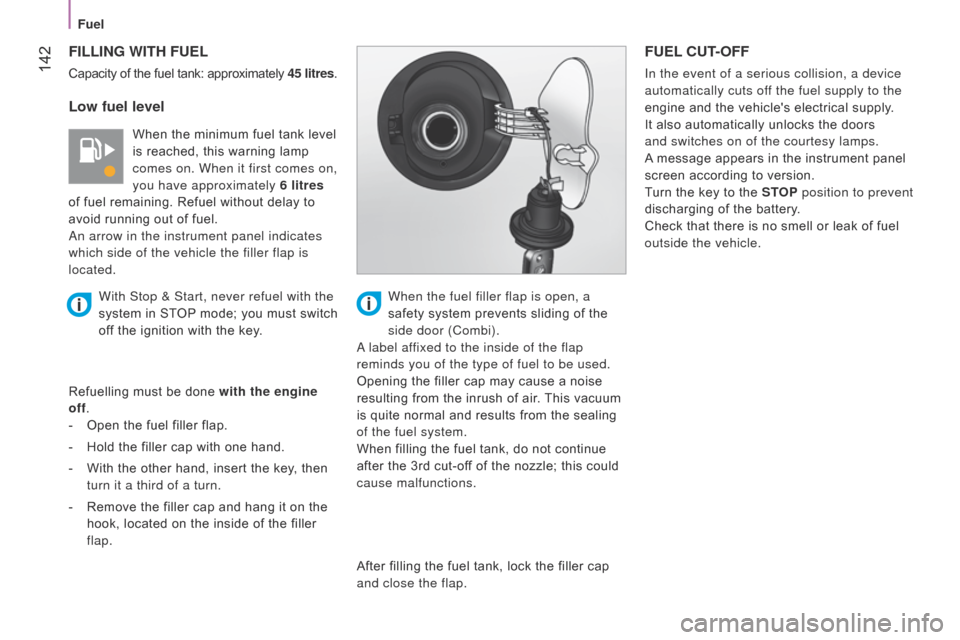
142
FILLING WITH FUEL
Capacity of the fuel tank: approximately 45 litres.
Low fuel level
When the minimum fuel tank level
is reached, this warning lamp
comes on. When it first comes on,
you have approximately 6 litres
of fuel remaining. Refuel without delay to
avoid running out of fuel.
a
n arrow in the instrument panel indicates
which side of the vehicle the filler flap is
located.
Refuelling must be done with the engine
off.
-
Open the fuel filler flap.
-
Hold the filler cap with one hand.
-
With the other hand, insert the key
, then
turn it a third of a turn.
-
Remove the filler cap and hang it on the
hook, located on the inside of the filler
flap.
FUEL CUT-OFF
In the event of a serious collision, a device
automatically cuts off the fuel supply to the
engine and the vehicle's electrical supply.
It also automatically unlocks the doors
and switches on of the courtesy lamps.
A
message appears in the instrument panel
screen according to version.
Turn the key to the STOP position to prevent
discharging of the battery.
Check that there is no smell or leak of fuel
outside the vehicle.
With Stop & Start, never refuel with the
system in STOP mode; you must switch
off the ignition with the key. When the fuel filler flap is open, a
safety system prevents sliding of the
side door (Combi).
a label af
fixed to the inside of the flap
reminds you of the type of fuel to be used.
Opening the filler cap may cause a noise
resulting from the inrush of air. This vacuum
is quite normal and results from the sealing
of the fuel system.
When filling the fuel tank, do not continue
after the 3rd cut-off of the nozzle; this could
cause malfunctions.
After filling the fuel tank, lock the filler cap
and close the flap.
Fuel
Page 145 of 192
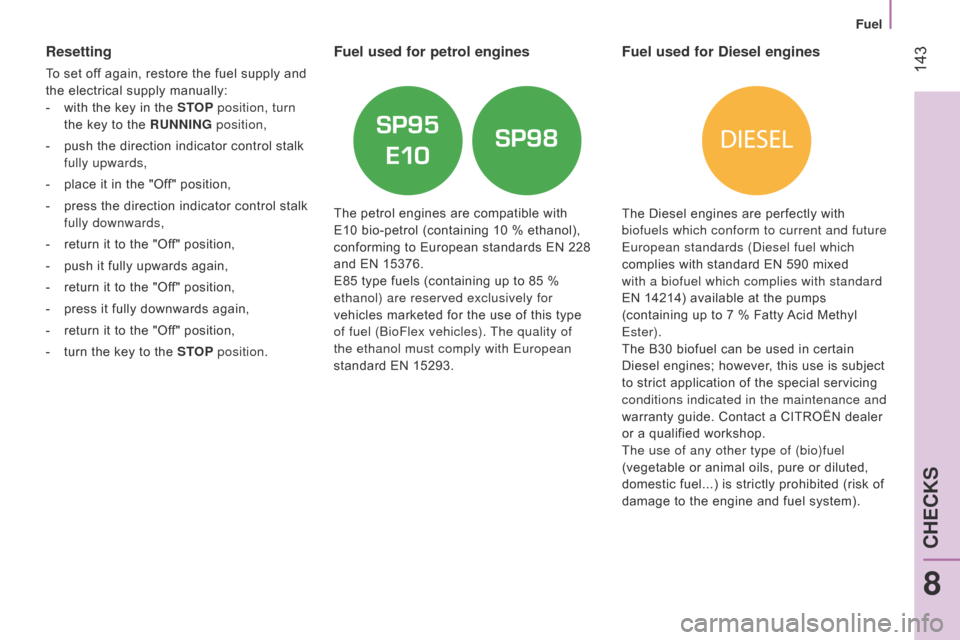
143
Resetting
To set off again, restore the fuel supply and
the electrical supply manually:
-
with the key in the
STOP position, turn
the key to the RUNNING position,
-
push the direction indicator control stalk
fully upwards,
-
place it in the "Of
f" position,
-
press the direction indicator control stalk
fully downwards,
-
return it to the "Of
f" position,
-
push it fully upwards again,
-
return it to the "Of
f" position,
-
press it fully downwards again,
-
return it to the "Of
f" position,
-
turn the key to the
STOP position.
Fuel used for petrol engines
The petrol engines are compatible with
E10 bio-petrol (containing 10 % ethanol),
conforming to European standards EN 228
and EN 15376.
E85 type fuels (containing up to 85 %
ethanol) are reserved exclusively for
vehicles marketed for the use of this type
of fuel (b ioFlex vehicles). The quality of
the ethanol must comply with European
standard EN 15293.
Fuel used for Diesel engines
The Diesel engines are perfectly with
biofuels which conform to current and future
European standards (
d iesel fuel which
complies with standard EN 590 mixed
with a biofuel which complies with standard
EN 14214) available at the pumps
(containing up to 7 % Fatty Acid Methyl
Ester).
The B30 biofuel can be used in certain
Diesel engines; however, this use is subject
to strict application of the special servicing
conditions indicated in the maintenance and
warranty guide. Contact a CITROËN dealer
or a qualified workshop.
The use of any other type of (bio)fuel
(vegetable or animal oils, pure or diluted,
domestic fuel...) is strictly prohibited (risk of
damage to the engine and fuel system).
8
CHECKS
Fuel
Page 146 of 192
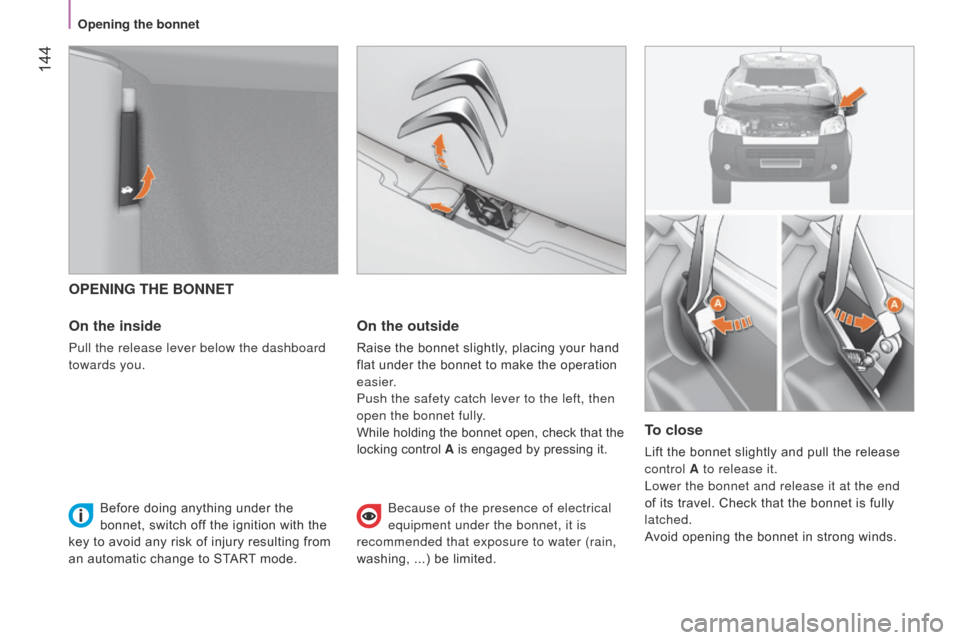
144
OPENING THE BONNET
On the inside
Pull the release lever below the dashboard
towards you.
On the outside
Raise the bonnet slightly, placing your hand
flat under the bonnet to make the operation
easier.
Push the safety catch lever to the left, then
open the bonnet fully.
While holding the bonnet open, check that the
locking control A is engaged by pressing it.
To close
Lift the bonnet slightly and pull the release
control A to release it.
Lower the bonnet and release it at the end
of its travel. Check that the bonnet is fully
latched.
Avoid opening the bonnet in strong winds.
Before doing anything under the
bonnet, switch off the ignition with the
key to avoid any risk of injury resulting from
an automatic change to START mode.
b
ecause of the presence of electrical
equipment under the bonnet, it is
recommended that exposure to water (rain,
washing, ...) be limited.
Opening the bonnet
Page 147 of 192
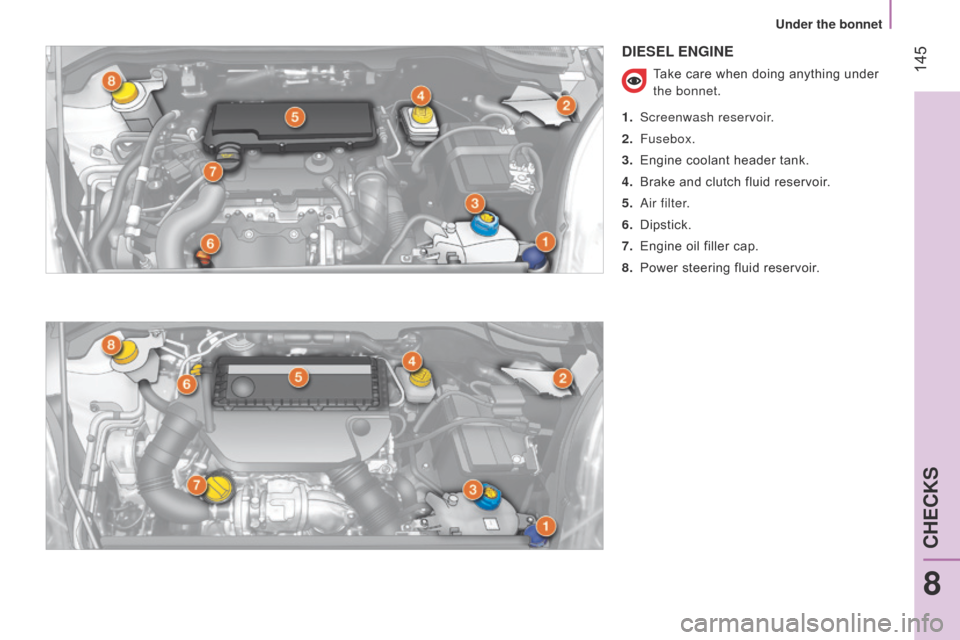
145
DIESEL ENGINE
Take care when doing anything under
the bonnet.
1.
Screenwash reservoir
.
2.
Fusebox.
3.
Engine coolant header tank.
4.
Brake and clutch fluid reservoir
.
5.
a
ir filter.
6.
Dipstick.
7.
Engine oil filler cap.
8.
Power steering fluid reservoir
.
8
CHECKS
Under the bonnet
Page 148 of 192
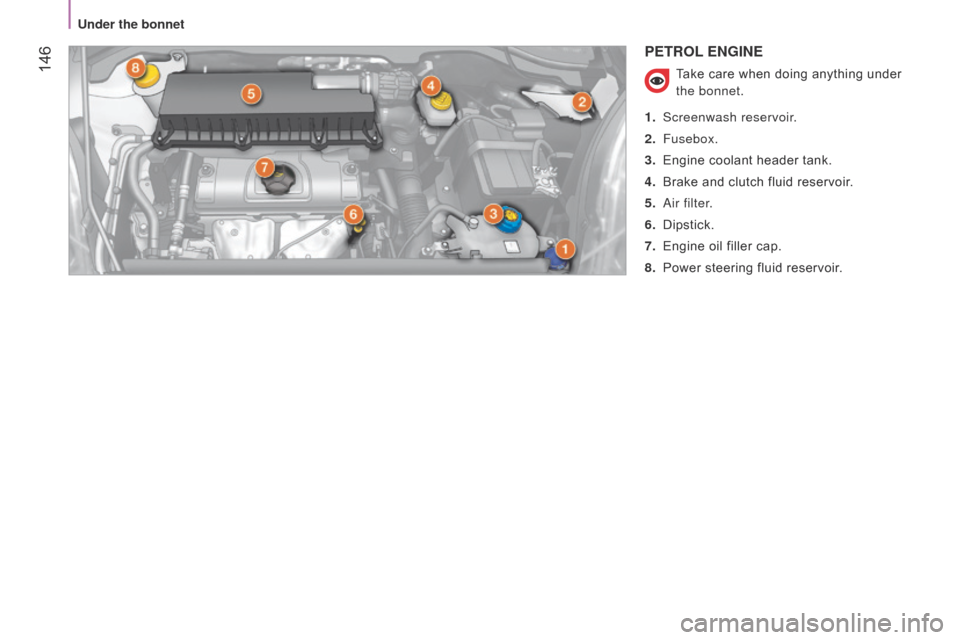
146
PETROL ENGINE
Take care when doing anything under
the bonnet.
1.
Screenwash reservoir
.
2.
Fusebox.
3.
Engine coolant header tank.
4.
Brake and clutch fluid reservoir
.
5.
a
ir filter.
6.
Dipstick.
7.
Engine oil filler cap.
8.
Power steering fluid reservoir
.
Under the bonnet
Page 149 of 192
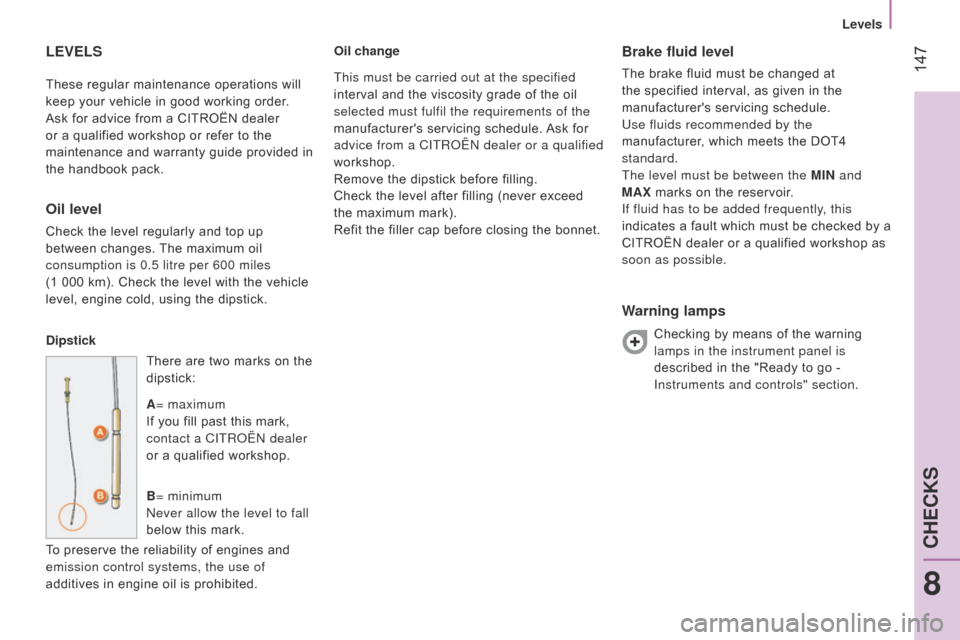
147These regular maintenance operations will
keep your vehicle in good working order.
Ask for advice from a CITROËN dealer
or a qualified workshop or refer to the
maintenance and warranty guide provided in
the handbook pack.
LEVELS
Oil level
Check the level regularly and top up
between changes. The maximum oil
consumption is 0.5 litre per 600 miles
(1 000
km). Check the level with the vehicle
level, engine cold, using the dipstick.
Dipstick There are two marks on the
dipstick:
A= maximum
If you fill past this mark,
contact a CITR
o Ë n dealer
or a qualified workshop.
B = minimum
n
ever allow the level to fall
below this mark.
To preserve the reliability of engines and
emission control systems, the use of
additives in engine oil is prohibited. Oil change
Brake fluid level
The brake fluid must be changed at
the specified interval, as given in the
manufacturer's servicing schedule.
Use fluids recommended by the
manufacturer, which meets the DOT4
standard.
The level must be between the MIN and
MAX marks on the reservoir.
If fluid has to be added frequently, this
indicates a fault which must be checked by a
CITROËN dealer or a qualified workshop as
soon as possible.
Warning lamps
Checking by means of the warning
lamps in the instrument panel is
described in the "Ready to go -
Instruments and controls" section.
This must be carried out at the specified
interval and the viscosity grade of the oil
selected must fulfil the requirements of the
manufacturer's servicing schedule. Ask for
advice from a CITR
o
Ë
n
dealer or a qualified
workshop.
Remove the dipstick before filling.
Check the level after filling (never exceed
the maximum mark).
Refit the filler cap before closing the bonnet.
8
CHECKS
Levels
Page 150 of 192
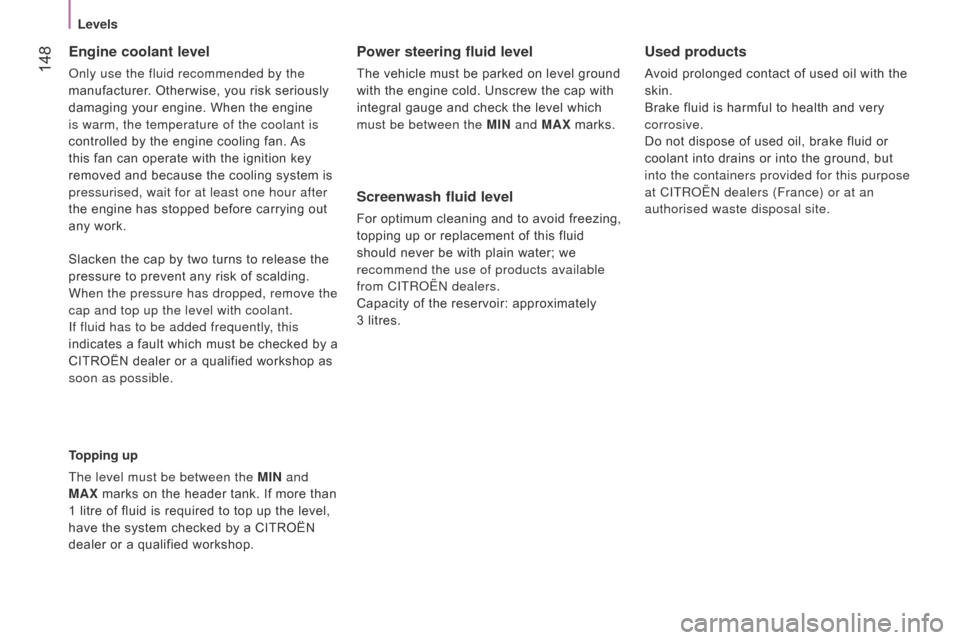
148
Engine coolant level
only use the fluid recommended by the
manufacturer . Otherwise, you risk seriously
damaging your engine. When the engine
is warm, the temperature of the coolant is
controlled by the engine cooling fan. As
this fan can operate with the ignition key
removed and because the cooling system is
pressurised, wait for at least one hour after
the engine has stopped before carrying out
any work.
Topping up
The level must be between the MIN and
MAX marks on the header tank. If more than
1 litre of fluid is required to top up the level,
have the system checked by a CITROËN
dealer or a qualified workshop.
Power steering fluid level
The vehicle must be parked on level ground
with the engine cold. Unscrew the cap with
integral gauge and check the level which
must be between the MIN and MAX marks.
Screenwash fluid level
For optimum cleaning and to avoid freezing,
topping up or replacement of this fluid
should never be with plain water; we
recommend the use of products available
from CITR
o Ë n dealers.
Capacity of the reservoir: approximately
3
litres.
Slacken the cap by two turns to release the
pressure to prevent any risk of scalding.
When the pressure has dropped, remove the
cap and top up the level with coolant.
If fluid has to be added frequently, this
indicates a fault which must be checked by a
CITROËN dealer or a qualified workshop as
soon as possible.
Used products
Avoid prolonged contact of used oil with the
skin.
Brake fluid is harmful to health and very
corrosive.
Do not dispose of used oil, brake fluid or
coolant into drains or into the ground, but
into the containers provided for this purpose
at CITR
o Ë n dealers (France) or at an
authorised waste disposal site.
Levels